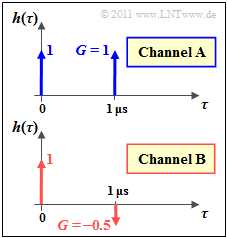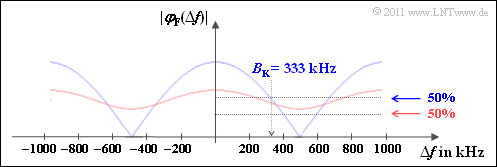Exercise 2.7Z: Coherence Bandwidth of the LTI Two-Path Channel
For the GWSSUS–model, two parameters are given, which both statistically capture the resulting delay $\tau$ . More information on the topic „multipath propagation” can be found in section Simulation gemäß dem GWSSUS–Modell of the theory part.
- The delay spread $T_{\rm V}$ is by definition equal to the standard deviation of the random variable $\tau$.
This can be determined from the probability density $f_{\rm V}(\tau)$ . The PDF $f_{\rm V}(\tau)$ has the same shape as the delay power density spectrum ${\it \Phi}_{\rm V}(\tau)$. - The coherence bandwidth $B_{\rm K}$ describes the same situation in the frequency domain.
It is defined as the value of $\Delta f$ at which the magnitude of the frequency correlation function $\varphi_{\rm F}(\Delta f)$ first drops to half its maximum value:
- $$|\varphi_{\rm F}(\Delta f = B_{\rm K})| \stackrel {!}{=} {1}/{2} \cdot |\varphi_{\rm F}(\Delta f = 0)| \hspace{0.05cm}.$$
The relationship between ${\it \Phi}_{\rm V}(\tau)$ and $\varphi_{\rm F}(\Delta f)$ is given by the Fourier transform:
- $$\varphi_{\rm F}(\Delta f) \hspace{0.2cm} {\bullet\!\!-\!\!\!-\!\!\!-\!\!\circ} \hspace{0.2cm} {\it \Phi}_{\rm V}(\tau)\hspace{0.05cm}.$$
- Both definitions are only partially suitable for a time-invariant channel.
- For a time invariant two-path channel (i.e. one with constant path weights according to the above graph), the following approximation for the coherence bandwidth is often used:
- $$B_{\rm K}\hspace{0.01cm}' = \frac{1}{\tau_{\rm max} - \tau_{\rm min}} \hspace{0.05cm}.$$
In this task we want to clarify
- why there are different definitions for the coherence bandwidth in the literature,
- which connection exists between $B_{\rm K}$ and $B_{\rm K}\hspace{0.01cm}'$ and
- which definitions make sense for which boundary conditions.
Notes:
- This task belongs to the chapter Das GWSSUS–Kanalmodell.
- This task also refers to some theory pages in chapter Mehrwegeempfang beim Mobilfunk.
Questionnaire
Sample solution
- That's why both channels have the same value:
$$B_{\rm K}\hspace{0.01cm}' \ \ \underline {= 1000 \ \rm kHz}.$$
(2) The graphs refer to the impulse response $h(\tau)$.
- To obtain the delay–power density spectrum, the weights must be squared:
- $${\it \Phi}_{\rm V}(\tau) = 1^2 \cdot \delta(\tau) + G^2 \cdot \delta(\tau - \tau_0) \hspace{0.05cm}.$$
- The integral of ${\it \Phi}_{\rm V}(\tau)$ is therefore $1 + G^2$.
- The probability density function (PDF), however, must have „area 1” (i.e., the sum of the two Dirac weights must be $1$). From this follows:
- $$f_{\rm V}(\tau) = \frac{1}{1 + G^2} \cdot \delta(\tau) + \frac{G^2}{1 + G^2} \cdot \delta(\tau - \tau_0) \hspace{0.05cm}.$$
- So only solution 3 is correct.
- The first option does not describe the PDF $f_{\rm V}(\tau)$, but the impulse response $h(\tau)$.
- The second equation specifies the delay –power spectral density ${\it \Phi}_{\rm V}(\tau)$.
(3) For channel $\rm A$ the two impulse weights are equal.
- This means that the mean value $m_{\rm V}$ and the standard deviation $\sigma_{\rm V} = T_{\rm V}$ can be computed simply:
- $$m_{\rm V} = \frac{\tau_0}{2} \hspace{0.15cm} {= 0.5\,{\rm µ s}}\hspace{0.05cm}, \hspace{0.2cm}T_{\rm V} = \sigma_{\rm V} =\frac{\tau_0}{2} \hspace{0.15cm}\underline {= 0.5\,{\rm µ s}} \hspace{0.05cm}.$$
For channel $\rm B$ the Dirac weights are $1/(1+0.5^2) = 0.8$ (for $\tau = 0$) and $0.2$ (for $\tau = 1 \ \rm µ s$).
- According to the basic laws of statistics, the noncentral first and second order moments are:
- $$m_{\rm 1} \hspace{-0.1cm} \ = \ \hspace{-0.1cm} 0.8 \cdot 0 + 0.2 \cdot 1\,{\rm µ s} = 0.2\,{\rm µ s} \hspace{0.05cm},\hspace{0.5cm} m_{\rm 2} \hspace{-0.1cm} \ = \ \hspace{-0.1cm} 0.8 \cdot 0^2 + 0.2 \cdot (1\,{\rm µ s})^2 = 0.2\,({\rm µ s})^2 \hspace{0.05cm}.$$
- To get the result you are looking for you can use the Steiner's Theorem.
- $$\sigma_{\rm V}^2 = m_{\rm 2} - m_{\rm 1}^2 = 0.2\,({\rm µ s})^2 - (0.2\,{\rm µ s})^2 = 0.16\,({\rm µ s})^2 \hspace{0.3cm}\Rightarrow \hspace{0.3cm}T_{\rm V} = \sigma_{\rm V} \hspace{0.15cm}\underline {= 0.4\,{\rm µ s}}\hspace{0.05cm}.$$
(4) The frequency correlation function is the Fourier transform of ${\it \Phi}_{\rm V}(\tau) = \delta(\tau) + \delta(\tau \, – \tau_0)$:
- $$\varphi_{\rm F}(\Delta f) = 1 + {\rm exp}(-{\rm j} \cdot 2\pi \cdot \Delta f \cdot \tau_0) = 1 + {\rm cos}(2\pi \cdot \Delta f \cdot \tau_0) -{\rm j} \cdot {\rm sin}(2\pi \cdot \Delta f \cdot \tau_0) $$
- $$\Rightarrow \hspace{0.3cm} |\varphi_{\rm F}(\Delta f)| = \sqrt{2 + 2 \cdot {\rm cos}(2\pi \cdot \Delta f \cdot \tau_0) }\hspace{0.05cm}.$$
- The maximum at $\delta f = 0$ is equal to $2$.
- Therefore the equation to determine $B_{\rm K}$ is
$$|\varphi_{\rm F}(B_{\rm K})| = 1 \hspace{0.3cm} $$ $$\Rightarrow \hspace{0.3cm}|\varphi_{\rm F}(B_{\rm K})|^2 = 1 \hspace{0.3cm} \Rightarrow \hspace{0.3cm}2 + 2 \cdot {\rm cos}(2\pi \cdot B_{\rm K} \cdot \tau_0) = 1$$ $$\Rightarrow \hspace{0.3cm}{\rm cos}(2\pi \cdot B_{\rm K} \cdot \tau_0) = -0.5 \hspace{0.3cm} $$ $$\Rightarrow \hspace{0.3cm}2\pi \cdot B_{\rm K} \cdot \tau_0 = \frac{2\pi}{3}\hspace{0.3cm} \Rightarrow \hspace{0.3cm}B_{\rm K} = \frac{1}{3\tau_0} = 333\,{\rm kHz}\hspace{0.05cm}.$$
- Solution 1 is therefore correct. The graph (blue curve) illustrates the result.
(5) For channel ${\rm B}$ the corresponding equations are
- $${\it \Phi}_{\rm V}(\tau) \hspace{-0.1cm} \ = \ \hspace{-0.1cm} 1^2 \cdot \delta(\tau) + (-0.5)^2 \cdot \delta(\tau - \tau_0) \hspace{0.05cm},\hspace{0.05cm} \varphi_{\rm F}(\Delta f) \hspace{-0.1cm} \ = \ \hspace{-0.1cm} 1 + 0.25 \cdot {\rm cos}(2\pi \cdot \Delta f \cdot \tau_0) -{\rm j} \cdot 0.25 \cdot {\rm sin}(2\pi \cdot \Delta f \cdot \tau_0)\hspace{0.05cm},$$
- $$|\varphi_{\rm F}(\Delta f)| \hspace{-0.1cm} \ = \ \hspace{-0.1cm}= \sqrt{\frac{17}{16} + \frac{1}{2} \cdot {\rm cos}(2\pi \cdot \Delta f \cdot \tau_0) }\hspace{0.3cm} \Rightarrow \hspace{0.3cm}{\rm Max}\hspace{0.1cm}|\varphi_{\rm F}(\Delta f)| = 1.25\hspace{0.05cm},\hspace{0.2cm}{\rm Min}\hspace{0.1cm}|\varphi_{\rm F}(\Delta f)| = 0.75\hspace{0.05cm}.$$
- You can see from this result that the $50\%$–coherence bandwidth cannot be specified here.
- Therefore, solution 4 is correct.
This result is the reason why there are different definitions for the coherence range in the literature, for example
- the $90\%$–coherence bandwidth (in the example $B_{\rm K, \hspace{0.03cm} 90\%} =184 \ \ \rm kHz$),
- the very simple approximation $B_{\rm K}\hspace{0.01cm}'$ given above (in the example $B_{\rm K}\hspace{0.01cm}' =1 \ \ \rm MHz$)
You can see from these numerical values that all the information on this is very vague and that the individual „coherence bandwidths” can be very different.

